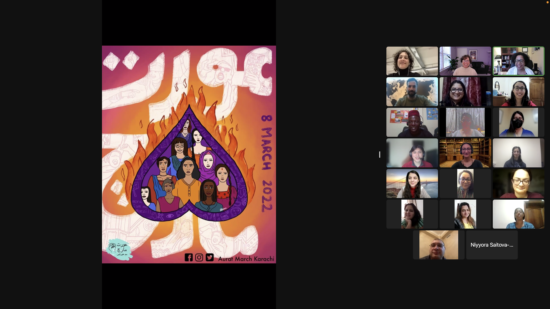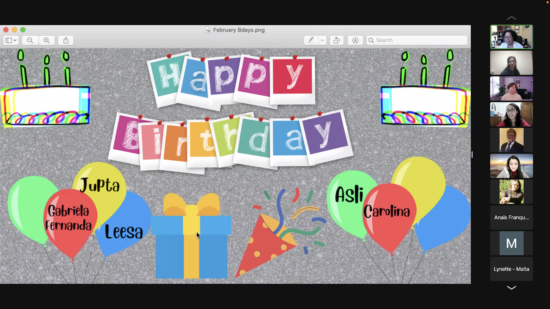By Leesa Fields and Minnie Battle Mayes, Bridge Builders for “A Global Moment in Time: Peace and Justice”
All images provided by the authors.
In last month’s Exchanges Matter column, Bridge Builders Brittany Lynk and Bonnie Beard introduced the Global Moment in Time (GMiT) International Visitor Leadership Program (IVLP) initiative and its unique hybrid format. The hybrid format begins with a virtual exchange and ends with an in-person exchange; in between, there is a 10-month “bridge” period coordinated by two Bridge Builders assigned to each project. The GMiT initiative includes three IVLP projects, each lead by a different pair of Bridge Builders and National Program Agency (NPA) partner. These projects include:
- Photojournalists Document Challenges and Opportunities in the COVID Era
- NPA: World Learning
- Bridge Builders: Bonnie Beard and Brittany Lynk
- Reflections on Diversity, Equity, Inclusion, and Accessibility
- NPA: Meridian International Center
- Bridge Builders: Belinda Chiu and Jennifer Strauss Gurss
- Peace and Justice
- NPA: IIE
- Bridge Builders: Minnie Battle Mayes and Leesa Fields
We are the Bridge Builders for the Peace and Justice GMiT. Our group consists of 77 participants from 54 countries across 17 time zones; they are leaders in human rights, legal and political affairs, youth and gender-based issues, and more. Bridge Builders are part coordinators, part programmers, and part international visitor liaisons. Our role is to keep the international visitors connected by creating a space for sharing and learning.

Ahead of International Women’s Day (March 8), participants on the Peace and Justice IVLP Bridge discuss women’s empowerment and share a poster for a women’s march (Aurat) in Karachi, Pakistan.
Our group meets twice a month, at different times, to allow as many participants as possible to attend. The group is eager to connect, share their work experiences, and start establishing collaborative projects. One way we are encouraging this is through the formation of panels for them to present to the cohort at large. Panel topics include women’s empowerment, human rights, hate speech, youth projects, and migration/immigration, and there is a possibility that some panels may be open to the Global Ties Network. However, due to the sensitive nature of some topics, we are very cognizant of the need to preserve the safety and privacy of participants as they share and learn from each other.
We also plan cultural experiences. In December we took a virtual tour of Washington, DC led by David Shaw of Off the Records Tours. Some visitors “attended” with family members. Comments ranged from “I can’t wait to visit these places in person” to “this tour was amazing!”
In January, we toured the International Civil Rights Center and Museum in Greensboro, NC. The visitors were quite moved by the experience, and shared comments including: “Great insights and excellent presentation. I am asking and answering questions about my local reality in my head,” to “The people of the Peaceful Movement are heroes all over the world!,” and “Thank you for this important historic tour for us today! So much ground covered.”
In another community building effort, February sessions have included “Welcome to My World” presentations in which participants show their professional or home life, live or via video.

Participants celebrate a group birthday with a virtual cake and song that bridges multiple time zones.
Many people see the virtual space as an unlikely place for exchange. They think it is “just not the same as in-person programs.” They are correct, it is not the same, but it is not necessarily any less powerful. There are many advantages of virtual programs that we can appreciate:
- Virtual programs level the playing field in many ways – people who cannot leave their families or their work to come to the United States for three weeks are able to participate.
- It is a wonderful opportunity to use technology to continue to connect international visitors after the IVLP ends and.
- We can reach and include more participants (77 participants across 17 times zones).
- It is an environmentally friendly reduction of our carbon footprint.
- Virtual exchanges add a new and exciting facet to IVLP and will take alumni interaction to another level.
- And lastly, it is less costly.
Naturally, there are some challenges with virtual exchanges:
- Bandwidth is the most prevalent problem. Some international visitors live in places where the internet is slow, restricted, or both. In some countries, participants do not have internet access at home and must rely on their workplace or an American Center for access.
- It is not uncommon for visitors to turn off their cameras to increase their bandwidth. This takes a little bit away from the interpersonal nature of the exchange.
- Seventeen (17) time zones are represented in our Bridge program. Many of our participants are logging in after work or in the middle of the night – what dedication!
One of the most rewarding aspects about working on this project is seeing how excited the participants are to be able to continue and expand their conversations with each other. Communication among group members is lively and we can see the camaraderie. They answer each other’s questions, share successes, challenges, photos, as well as regrets when they miss a session.
Alumni engagement is one of the greatest advantages of the bridge program. Participants gain knowledge and build relationships with each other, and sometimes with community-based partners and interlocutors they met during the virtual program. We believe they could, in the future, create even stronger alumni engagement projects.
A Global Moment in Time is not only a new programming model for IVLP, it is also a new initiative—the project launched in October 2021—and we are all new to our Bridge Builder roles. As such, the six Bridge Builders for the three GMiT themes communicate regularly with each other and in “huddles” with our IVLP program teams at the Bureau of Educational and Cultural Affairs and NPAs to share information and ideas, and to ensure the success of all three GMiT programs.
Yes, we are building the plane as we fly, but the ride is much smoother than one would think. This new GMiT initiative allows us the opportunity to create a sense of community, among large groups of international visitors who will know each other well when they are finally able to meet. We look forward to sharing more of what we learn at the end of this groundbreaking project.
